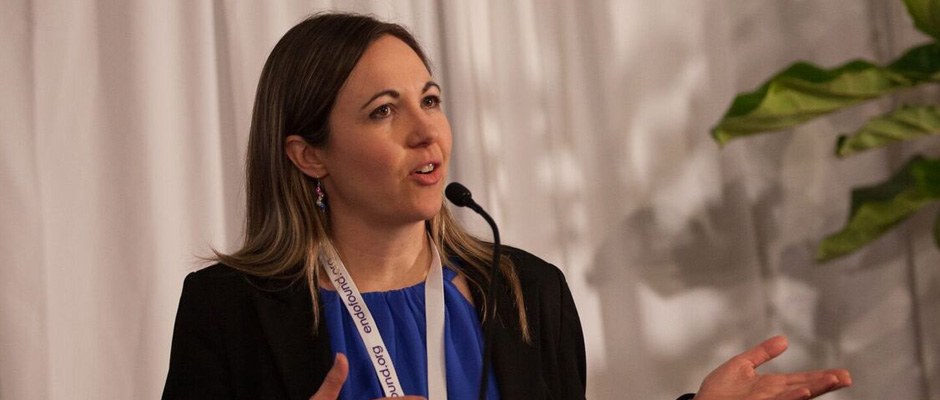PATIENT AWARENESS DAY 2018: LIVING YOUR BEST LIFE WITH ENDO
Sunday, March 18, 2018, (8am-5pm) Einhorn Auditorium (131 E76th st) at Lenox Hill Hospital, NYC
DotLab: The first non-invasive test for aiding in the diagnosis of endometriosis
Juliana Ansari, Ph.D.
- Thanks for the opportunity to speak. My name's Juliana Ansari and I'm here from DotLab. DotLab is a personalized medicine company for women's health. And what I'm going to discuss with you today is some of the early work around our first product, DotEndo, which is a non-invasive test to help detect endometriosis. And the clicker works. I'd like to start by just drawing a contrast between the world as it is today and the world in which the DotLab test is available. Clearly, many of you are acutely aware of the insufficiencies of the current diagnosis and management. The disease currently requires laparoscopic surgery for confirmation, which is invasive, requires anesthesia and is expensive. Again, I think this is clear to many people in the room that time to diagnosis, the long delay of up to 10 years, is really unacceptable and increases the time of suffering where if people were diagnosed sooner, they could be treated sooner. There's lots of cases of either missing the condition all together or diagnosis as, misdiagnosis as another disorder. Even some people who are on oral contraceptives, which is the first line of therapy, a lot of times will actually suppress symptoms so there may be women who don't realize that they have endometriosis because of being on birth control. DotLab has developed a test that is detecting biomarkers that are circulating the body. These biomarkers are actually microRNAs. So our test is completely non-invasive. Something that any patient can easily take, and at this time, we're beginning as a medical grade test. It will be a physician initiated order, that while currently only a subset of OBGYN's can diagnose and identify endometriosis, this test could be ordered by a wide range of physicians in order to identify markers of the disease. The test in our clinical studies has been shown to be quite accurate with over 95% sensitivity and specificity. Our most recent study, a perspective study, which I'll show a little bit about in the coming slides. This can actually detect all stages of the disease from minimal, mild to moderate and severe. So it doesn't only detect a very severe stages of endometriosis. The microRNA analysis, we will be able to offer the results within two weeks from the lab receiving the patient's sample. So we're super excited, the test is set to launch later in 2018. I'd like to just highlight some of the differences between the DotLab test verses what else is available currently or in development. I'm not used to looking there, so I'm sorry if I'm not looking at people This shows a, whoops, not going to do that. This is just comparing non-invasive towards the top with invasive towards the bottom. And then diagnosing active disease, or confirming active disease, versus predicting susceptibility to the disease. So DotLab is in the quadrant there where it's actually able to detect active disease in a non-invasive way. Clearly the laparoscopy is invasive, requires time for recovery, the expense. There are several other tests, for example, genetic tests, which DotLab is not. These are actually looking at genes that are associated with developing endometriosis. These predict the risk of the disease but do not confirm the active disease at the time. So our test is the first to offer those two non-invasive and confirming the presence of the disease. In our biomarkers in our clinical studies have really stood on the shoulders of over 10 years of foundational works. So our chief medical officer and co-founder Dr. Hugh Taylor, is from the Yale School of Medicine and he's actually been researching endometriosis for about 25 years. And in the last 10 years, as he was looking at different genes that are involved in developing the disease, began to look at the role of microRNAs. So just quickly what those are. Instead of a regular gene, which is transcribed to a messenger RNA and then made into a protein, a microRNA is actually a small piece of RNA that regulates the expression of other genes. So it's not translated into a protein, but it is expressed in the body and they can actually circulate in blood, in saliva. So in these early studies he began to identify certain mircoRNAs that had a role in the disease. And this was the foundation for a comprehensive screen, which I'll share next. We've done several clinical studies, both a retrospective and prospective study. And we are looking forward to launching the test later in 2018. The publication I'm showing here is from Cosar and et all in 2016 in fertility and sterility. This isn't a exhaustive list but these bars here in color are showing specific microRNA sequences that were up regulated in patients that had already diagnosed stage three and four endometriosis. So what we did was, there was 48 patients total and compared the complete microRNA expression levels, so we took the micro array of microRNAs meaning one way to probe for over 1,000 or 2,000 microRNAs at the same time. And these are a few examples of the ones that were higher in the women with the disease or down regulated in the women with the disease. So they're very specific for endometriosis as compared to controls that are clinically relevant. So patients that may have been presenting with similar symptoms, but did not have the disease confirmed by laparoscopy. This is also from that publication. So we're showing AUC scores. So the ROC curve analysis is a way to help determine how accurate a biomarker is to identify the condition. So on an individual basis in this study the microRNAs had high AUC scores, the closer to one, the more accurate the diagnosis. In this particular set, once we were actually able to combine three microRNAs we could get very high AUC score that's shown in the upper right. And then individual scores are shown in the table. So these microRNAs are the basis for our panel. One thing that we're looking forward to publishing, hopefully this summer, was a prospective study, which is kind of the next level of rigor after a retrospective study. So in this case the study required 52 patients to power to be able to see the effect of different levels of the microRNAs. We actually enrolled 100 and I'll be showing you about 86 here. So what this is doing is, prior to laparoscopic surgery or laparotomy, samples are taken and women then undergo the procedure. And then what we do is compare, did our test correctly predict that they had endometriosis versus what the surgery showed. And we're really excited this patient group was more diverse than our previously published retrospective study. It included some women on medications and it included highly, all stages, so from stage one to four of endometriosis. The control group was a clinically relevant group with a very diverse pathology, so multiple different conditions that may be mistaken for endometriosis. That's why we really want to use the heterogonous group that you would encounter in a real world scenario. So after this we tested the original model that I showed of the first three microRNAs, on the left here. And it again performed very well to identify women with the condition. And from this we also were able to further refine the combination of microRNAs because this patient population included a wider variety of stages of the disease. And so from these we are finalizing, we finalized, what our test will actually look at. So by combining the signal from different microRNAs we're really honing in on something that's very specific for endometriosis. So you can keep an eye out for that publication soon. Links to our previously published work are available from the DotLab.com website. And I invite anyone to visit there and go to the for physicians page. There's also information there, my thing went out but yours didn't. There's also information for physicians to sign up for early access. So in the remaining time, I think we're a little behind, I'll just quickly discuss some of the patients that we believe that this could help. For our initial patient group we're looking at either infertility, where up to 50% of infertile patients may have endometriosis, as well as initial diagnosing, identifying the disease and determining what pain management strategies to use. And moving forward, we're really hoping DotLab test can be used for monitoring the disease to see whether the biomarkers go up and down. Maybe reflecting the effects of treatment or deciding what type of treatment to use. Just a little more information on the infertility. I think there's been some interesting discussions on this today, it's great to hear about those. And one seminal study on this is just that even suppressing. If endometriosis is identified soon and GnRH agonists are taken, even for three months, there is about a 50% increase in the success rate of IVF. So identifying it and treating it will help improve outcomes for women that are undergoing IVF. And I guess just to wrap up. So far we've had a really strong, positive feedback from patients on social media. And we were at the ASRM conference in the fall and our collaborators, I just opened a CD drive over here Our collaborators actually won several prizes for some of the work on biomarkers as well as some of the central nervous system sensitization. So that was very interesting to hear more about that. We just from being here today it's really clear that this type of early test could shift the paradigm and be really helpful to a lot of people. So I look forward to, feel free to direct your questions to me or email hello@dotlab. If you want to send a direct question or you can sign up on the contact page and we'll be sharing more information as we get closer to launch. So I appreciate your time and thank you so much.










